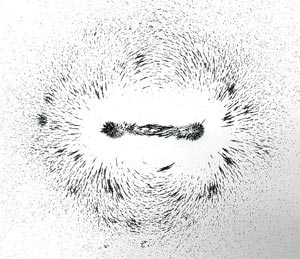Simple iron filings can be used for a variety of interesting experiments and demonstrations. Magnetism is a mysterious concept that can be difficult for students to grasp. Magnetic fields are the forces surrounding a magnet that are identified by how they interact with adjacent magnets and other metal objects. While magnetic fields are ‘invisible’ they can be observed by sprinkling iron filings on a white paper with magnets beneath.
By lightly coating the surface of the paper, the magnetic field will appear as filings align themselves with the field. Different magnets, depending on their strength and shape will create varying patterns in the iron filings. A bar magnet with a distinct north and south will show characteristic lines of a magnetic field. Circular magnets may show multiple lines indicating multiple magnet fields. The stronger neodymium magnets will cause the iron filings to pile up in spikes due to the increased strength. This demonstration can lead to a discussion about magnetic fields: What they are, Where they can be found, and How they are used in the world around us.
A simple magnetic fluid can be prepared by mixing iron filings with vegetable oil. This fluid will flow when free from a magnetic field and stop solid when next to a magnet. The mixture can be put in a glass or plastic vile so students can observe how the fluid flows. When the fluid is held over the magnet, it will pile up (as long as it is in the range of the magnetic field). When the magnet is removed, the tower will collapse into a puddle. Students can then experiment with magnets of varying strengths to observe how the strength of a magnet will affect the height of the tower that is able to be formed.
Iron filings can also be mixed with sand to illustrate how different substances interact with magnets. A pouch can be made out of freezer bags. (You will want to hot glue the openings to prevent spills, as seen in the picture.) When filled with a mixture of sand and iron, the bags can be made to appear homogeneous. You can ask your students what they think is in the bag. (Some perceptive students may come up with the correct answer depending on prior knowledge and the previous activities.) You can also ask if they think they would ever be able to separate the two substances. When you drag a magnet along the surface of the bag, the iron filings come to the surface, separating from the sand. This simple illustration can lead to discussion of what is magnetic and why. 
This is also a great activity to relate the idea of magnetism to a household toy that they should all be familiar with: the etch-a-sketch. This toy relies on a similar set up to make designs and, like our sand pouches, the designs disappear when the toy is shaken. A discussion of other applications of magnetism in the home will likely follow.
Michelle is a graduate student at the University of Notre Dame. She and another graduate student, Melanie Bunda, run a program called Science and Stories. This program focuses on children from ages 6 to 10 and allows the participants to explore science though books. They use a number of Super! Wow! Neat! science supplies from Educational Innovations.

